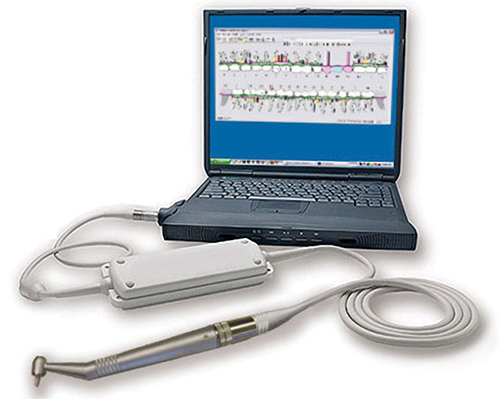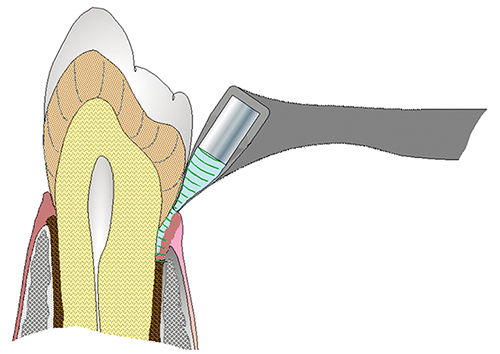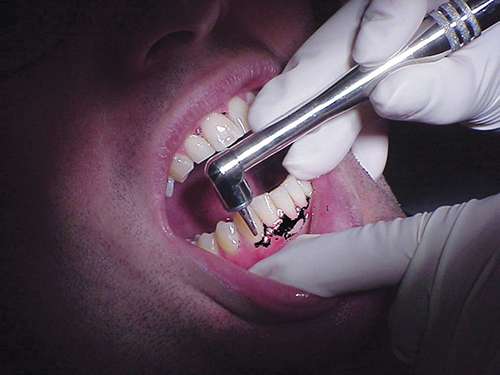Periodontal Probe Improves Exams, Alleviates Pain
Originating Technology/NASA Contribution
“Dentists,” comedian Bill Cosby memorably mused, “tell you not to pick your teeth with any sharp metal object. Then you sit in their chair, and the first thing they grab is an iron hook!” Conventional periodontal probing is indeed invasive, uncomfortable for the patient, and the results can vary greatly between dentists and even for repeated measurements by the same dentist. It is a necessary procedure, though, as periodontal disease is the most common dental disease, involving the loss of teeth by the gradual destruction of ligaments that hold teeth in their sockets in the jawbone. The disease usually results from an increased concentration of bacteria in the pocket, or sulcus, between the gums and teeth. These bacteria produce acids and other byproducts, which enlarge the sulcus by eroding the gums and the periodontal ligaments.
The sulcus normally has a depth of 1 to 2 millimeters, but in patients with early stages of periodontal disease, it has a depth of 3 to 5 millimeters. By measuring the depth of the sulcus, periodontists can have a good assessment of the disease’s progress. Presently, there are no reliable clinical indicators of periodontal disease activity, and the best available diagnostic aid, periodontal probing, can only measure what has already been lost. A method for detecting small increments of periodontal ligament breakdown would permit earlier diagnosis and intervention with less costly and time-consuming therapy, while overcoming the problems associated with conventional probing.
The painful, conventional method for probing may be destined for the archives of dental history, thanks to the development of ultrasound probing technologies. The roots of ultrasound probes are in an ultrasound-based time-of-flight technique routinely used to measure material thickness and length in the Nondestructive Evaluation Sciences Laboratory at Langley Research Center. The primary applications of that technology have been for corrosion detection and bolt tension measurements (Spinoff 2005). This ultrasound measurement system was adapted to the Periodontal Structures Mapping System, invented at Langley by John A. Companion, under the supervision of Dr. Joseph S. Heyman. Support of the research and development that led to this invention was provided by NASA’s Technology Applications Engineering Program and by the Naval Institute for Dental and Biomedical Research, in Great Lakes, Illinois. In fact, a request from the U.S. Navy spurred the development of the tool: A sailor on a submarine had to be airlifted 1 month into a 6-month tour due to a life threatening case of periodontal disease, costing the Navy millions of dollars as the mission had to be abandoned.
Partnership
Patented as the Ultrasonagraphic Probe (USProbe) in May 1998, Visual Programs Inc., of Richmond, Virginia, obtained an exclusive license for the system in January 2000. According to John Senn, of Visual Programs, the new device may be one of the major steps forward in the battle against periodontal disease. “The probe should be the next major piece of dental equipment. By using the new technology, dentists and hygienists will be able to perform exams earlier and may detect periodontal disease while the teeth can still be saved.” According to Jack Singer, the president of Visual Programs, “The name NASA has opened many doors for us that may not have been opened otherwise. It gives credibility to a new concept that otherwise might not have been accepted.”
Product Outcome
The USProbe mapping system is a noninvasive tool to make and record differential measurements of a patient’s periodontal ligaments relative to a fixed point, the boundary between the crown and root of a tooth, called the cemento-enamel junction (CEJ). The mapping system uses ultrasound to detect the top of the ligaments at various points around each tooth, and uses either ultrasound or an optical method to find the CEJ at the same points. The depth of the sulcus is calculated as the difference between these two points.
The probe used in the mouth to send and receive ultrasound signals is very small, and additional instrumentation is contained within a standard personal computer, allowing the entire measurement to be computerized. In addition, manual charting of pocket depth will be eliminated, since the data will be automatically transmitted to the computer. In addition to solving the problems associated with conventional probing, the USProbe may also provide information on the condition of the gum tissue and the quality and extent of the bond to the tooth surface.
Visual Programs developed the USProbe as the next-generation, state-of-the-art diagnostic tool for detecting and characterizing periodontal disease. The USProbe automatically detects, maps, and diagnoses problem areas by integrating diagnostic medical ultrasound techniques with advanced artificial intelligence. Visual Programs expects it will quickly become the industry standard technique, replacing the current uncomfortable and invasive techniques. NASA and Visual Programs are proud to contribute technology that will increase the number of healthy smiles and decrease the number of grimaces produced by their maintenance.

The first PC-based automated probe on the market, USProbe integrates with most charting systems and allows one person to conduct a periodontal probing diagnostic exam while recording the results.

The USProbe device rides along the gum line, sending a signal down the pocket between the gums and teeth. Echoes are recorded by an ultrasound transducer and then analyzed by a computer system. A foot pedal is used to start the flow of water, read data, and then send the information to a computer where it is fed into a charting software program.

Much more comfortable than conventional probing, USProbe uses a slight flow of water to ensure coupling of ultrasound in and out of tissues.













